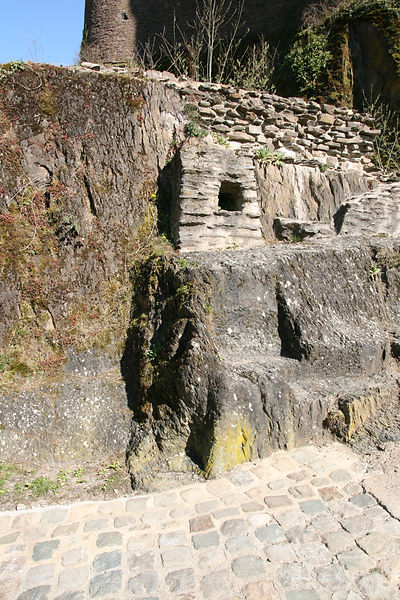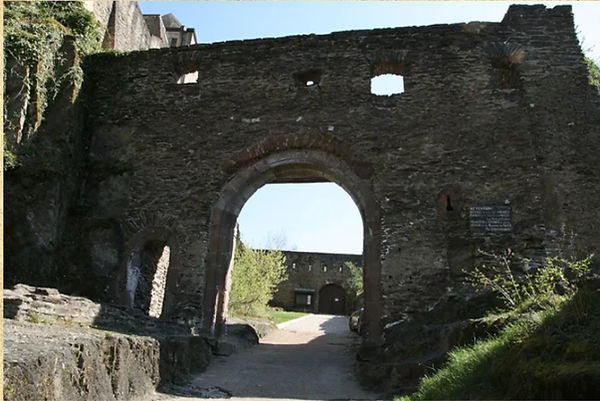
Bailey

Possibly, this space has been used since roman times. Nowadays, it's surrounded by modern buildings containing a café, souvenir shop and the visitor's centre. In the middle of the place, there is a walnut tree, planted by the late Grand Duke John as a typical symbol for Vianden.
Between the walnut tree and the glass facade of the visitor's centre, there is an area where archeological finds are still visible. A ramp-like trench cut into the rock is a former entrance alley, possibly dating back to roman times.
In the high middle ages many different buildings stood here which are difficult to interprete; but with little doubt they were containing stables, barns and workshops. One octogonal structure (still visible inside the visitor's centre) may have been a dovecote.
Pigeons were a very posh dish at a banquet, breeding and keeping pigeons was a royal prerogative, only the most important lords were entitled to this. Those who had the right to do so showed it by very impressing dovecotes, often octagonal at the outside, as this is a symbol for the royal prerogative.
In the 15th century the bailey received new buildings, now containing (in this order starting at today's café) a horse stable, a hay barn, a granary, a bakery, another horse stable and a brewery.
The first building behind the 4th gate on the right was added in the 17th century as a guard's house.
On the left side of the courtyard, one can see a rectagonal basin and a canal cut into the rock leading to it. Rainwater was collected here, and in the 16th century the basin was filled by a waterpipe transporting spring water from the nearby forest (see well).
castle entrance stairway & Fallbrück house


Todays stairway to the keep (or main castle building) is an interpretation of the former "knight's stairway". Beside this stairway an alley is leading to the backward courtyard. This alley formerly could be closed by a further gate and was covered by a timberwork structure called "Fallbrückhaus".
This had been a gallerylike room with 21 stained glass Windows. The name "Fallbrück" is a commemoration of a medieval drawing bridge having been on this site before.
the casting of the Caspar Bux cannon

In the first half of 2024, a long-term project will be realised at Vianden Castle:
Firstly, a flame furnace for melting bronze will be produced, as was common in the 17th century. This is followed by the casting mould for a cannon barrel. When everything is ready, the casting will take place, probably at the beginning of June 2024.
This is an experimental project; everything is to be done exactly according to the techniques of the 17th century. Dr Bastian Asmus, archaeo-metallurgist, is in charge of the project.

During excavation work at Brandenburg Castle (15 km from Vianden), 2 cannons were found from the workshop of the Vianden bell and gun founder Caspar Bux. These two pipes were recently rediscovered and are now on display in the Luxembourg Fortress Museum (M3E).
They are "falconets", i.e. small-calibre cannons which were intended for the defence of the castle. The shape looks quite old-fashioned, but the two barrels were probably made at the beginning of the 17th century.

Caspar Bux
There was a long tradition of bell casting in Vianden, and some products of the local art of bronze casting have survived to this day. Caspar Bux was the offspring of a long-established foundry family; the name " Bux " refers to the second mainstay of the bell founders : the manufacture of firearms (in German : Büchsen).
Among other things, Caspar Bux recast the so-called silver bell of Vianden Castle, which is now in the Trinitarian church.
%20Facebook.png)
the furnace
The small industrial revolution of the 16th century brought about a number of innovations that revolutionised metalworking. For example, the blast furnace for iron production (the first in the Duchy of Luxembourg was located here in Vianden), or the flame furnace for melting bronze.
In contrast to earlier smelting furnaces, the flame furnace was no longer fuelled with charcoal but with wood, which made higher temperatures possible.
From March to April 2024, such a flame furnace will be built in the farmyard.

The casting mould
Cannon casting was very similar to bell casting. The casting mould is produced in a similar way, which can probably be seen in the castle courtyard from April to May 2024

Dr Bastian Asmus
The specialist in archaeometallurgy first became known in Luxembourg in 2022 with the casting of a beehive bell.
You are welcome to stop him at work to ask your questions. In the initial phase, work is mainly carried out on the site from Mondays to Wednesdays
more info on ;
www.archäometallurgie.de
Follow the project !
As a member of the Friends of Vianden Castle, you have free admission to the castle and all events all year round. With an annual fee of 15.- (individual membership) or 25.- (family card) you can follow the progress of the work and also be present at the highlight, the casting.







